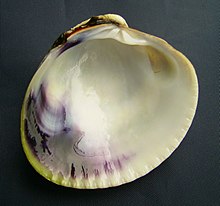|
Austrovenus stutchburyi
Austrovenus stutchburyi, common name the New Zealand cockle or New Zealand little neck clam, is an edible saltwater clam, a marine bivalve mollusc in the family Veneridae, the Venus clams. Its Māori name is tuangi (North Island) or tuaki (South Island).[1] HabitatCockles live in harbours and estuaries in New Zealand. They live in the subtidal to intertidal zone, and when they are in the intertidal zone they live between the low tide mark and the mid tide mark. Cockles are unable to survive above the mid tide mark because of the increased exposure time. Cockles prefer to live in soft mud and fine sand, however they can be suffocated by extremely fine sand. For this reason, they mainly live in areas with a large grain size. The cockles bury 2 to 3 cm under the sand. BodyCockles have a soft body which is protected from predation, desiccation and wave movement by a sturdy shell. Predators find it difficult to pierce the shell of adult cockles. Sea birds drop cockles from high up, smashing their shells, to eat the body, but fish (such as flounder) can't break the shells. Younger cockles are more vulnerable to predation because their shells aren't as hard as adult cockles. If a cockle lives in the intertidal zone it is protected against desiccation by the shell closing tightly together (the adductor muscles do this). A small amount of water is stored inside the shell, keeping the cockles body moist. Strong wave action can dislodge cockles. The shell prevents damage to the body when it is drifting around in the water. Predation and parasitesCockles are a major food source for South Island oystercatchers. An individual oystercatcher is estimated to eat around 200,000 cockles in a year. The flatworm Curtuteria australis is a parasite that infects cockles, demobilising them so that they are more easily eaten by oystercatchers. Once the larvae have been ingested by the birds, they lay eggs, which are excreted and consumed by whelks, who in turn are a food source for cockles.[2] LifespanIf not eaten by birds or humans, Austrovenus stutchburyi can live up to 20 years.[2] In a human contextCockles are a traditional food source for Māori. Historically, cockle beds were managed due to the risk of overharvesting, and rāhui were often placed in areas as a measure to allow cockle populations to recover.[2] Cockle shells were traditionally used as tweezers for hair removal.[2] See alsoReferences
Further reading
|
||||||||||||||||||||||||||||||||||||

